

 based on reviews by Pedro Cardoso and 1 anonymous reviewer
based on reviews by Pedro Cardoso and 1 anonymous reviewer

Biodiversity loss is occurring at an alarming rate across terrestrial and marine ecosystems, driven by various processes that degrade habitats and threaten species with extinction. Despite the urgency of this issue, empirical studies present a mixed picture, with some indicating declining trends while others show more complex patterns.
In a recent effort to better understand global biodiversity dynamics, Boennec et al. (2024) conducted a comprehensive literature review examining temporal trends in biodiversity. Their analysis reveals that reviews and meta-analyses, coupled with the use of global indicators, tend to report declining trends more frequently. Additionally, the study underscores a critical gap in research: the scarcity of investigations into the combined impact of multiple pressures on biodiversity at a global scale. This lack of understanding complicates efforts to identify the root causes of biodiversity changes and develop effective conservation strategies.
This study serves as a crucial reminder of the pressing need for long-term biodiversity monitoring and large-scale conservation studies. By filling these gaps in knowledge, researchers can provide policymakers and conservation practitioners with the insights necessary to mitigate biodiversity loss and safeguard ecosystems for future generations.
References
Boennec, M., Dakos, V. & Devictor, V. (2023). Sources of confusion in global biodiversity trend. bioRxiv, ver. 4 peer-reviewed and recommended by Peer Community in Ecology. https://doi.org/10.32942/X29W3H
DOI or URL of the preprint: https://doi.org/10.32942/X29W3H
Version of the preprint: 1
 , posted 24 Nov 2023, validated 24 Nov 2023
, posted 24 Nov 2023, validated 24 Nov 2023The organization and structure of the manuscript are logical and coherent, making it easy to follow the authors' line of reasoning. The writing style is clear, concise, and technically sound, with appropriate use of terminology.
This manuscript underwent evaluation by two reviewers who provided significant suggestions for improvement. A agree with both reviewers that there is the need of some additional work.
Please perform the additional analyses suggested by both referees
This manuscript intends to conduct a literature review of studies documenting the temporal dynamics of global biodiversity. The authors found that reviews and meta-analyses, along with the use of global indicators, are more likely to conclude that trends are declining and provide advice on future directions for research. This is a timely publication in view of many contradicting studies being released, namely on the insect extinction narrative (although not limited to it in any way). I do have a few suggestions for improvement as in many parts the text or analyses were not clear to me and in my view still require further thought and work.
It is not clear if there were thresholds applied and what they were to the different response categories. Most studies have at least some trends diverging from the general picture, how were these considered, in decline or mixed/factor-dependent results? Wonder if a continuous measure would not be more appropriate for the analyses, like % of declining trends among all species in a study.
I am missing a formal analysis of the results. It is often the case that conclusions are drawn from percentage of studies reaching some trend with no analysis of the data. I think at least a statistical model where the response variable is decline vs others (or the %declining as mentioned above) and the independent variables are the characteristics of the study is needed.
Minor comments:
- Everything mentioned in this study is about taxonomic diversity in one way or the other. It would be important to also mention functional, phylogenetic and eventually network diversity. Did the authors find any studies covering the trends in these facets of diversity? If not, maybe it is worth mentioning in the discussion why that is the case.
- Ln 60 - Regarding the use of the term biodiversity, two suggestions to add regarding many sources of confusion: https://doi.org/10.1146/annurev-environ-120120-054300 and https://doi.org/10.1016/j.cub.2022.12.003
- Ln 168 – Wonder if and how it is possible to study drivers without trends as they are drivers of trends? Maybe some clarification here is needed?
- Table 1 is not clear. Is “Contant” “Constant”? Or “Content”? Maybe better naming is needed in any case. In Taxa, how were the numbers calculated? For example, 8 in total means 8 large groups? How were the large groups identified?
- Ln 306 – I would not say it is surprising. Species loss is always preceded by population decline, so trends of population decline must always be stronger than trends of extinction.
- Ln 482 – No mention is given to the recent Kunming-Montreal agreement and targets.
Pedro Cardoso
https://doi.org/10.24072/pci.ecology.100588.rev12